Market update: Specialty aerials in the U.S.
21 September 2022
Ebbe Christensen has weathered a number of storms – both figuratively and literally.
In 2011, Christensen, who serves as president and CEO of Texas-based Ruthmann ReachMaster, received the first of what would be a string of unfortunate events.
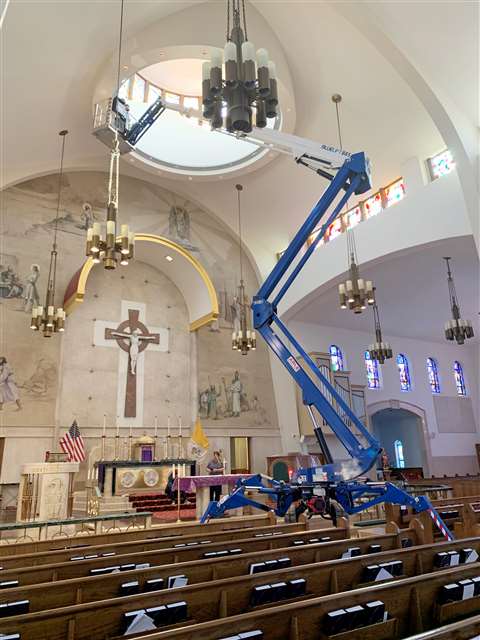 The track-based compact lift category has firmly established itself as a stable and solid product for both rental and end-users, says Ruthmann ReachMaster. (Photo: ABLE Equipment Rental)
The track-based compact lift category has firmly established itself as a stable and solid product for both rental and end-users, says Ruthmann ReachMaster. (Photo: ABLE Equipment Rental)
“I was in Denmark when I got a call from my CFO,” Christensen told me back then. “He said, ‘I have some bad news for you. Your warehouse is on fire. It’s still burning and this is not a bad joke.’ I said, ‘How bad?’ and he said, ‘Bad. It’s gone.’”
The warehouse, which had been a few stores down from a shop that was welding equipment on a conveyer belt, was unsalvageable.
“Everything we had except our offices went up [in flames,]” Christensen said. “Falcons, Hinowas, all of our spare parts – everything – incinerated.”
Supply chain challenges
Fast-forward six years and Christensen would, yet again, watch disaster strike as Hurricane Harvey descended upon Texas and brought with it massive flooding and damage. The company’s headquarters took on water and had extensive roof damage. But as they did before, the team rallied and worked to overcome Mother Nature’s wrath.
And, like the rest of the world, in 2020, the company faced what would change our world forever – Covid-19. The global pandemic brought, which brought with it challenges no one could have ever predicted, still lingers, and the issues resulting from it, alongside the war in Ukraine, have made 2022 difficult for the industry as a whole.
Yet, like it has in the past, Ruthmann ReachMaster pulled itself up by its bootstraps and forged on.
“Like everyone else in the industry we are certainly having our challenges on the supply chain side with delays in production caused by either limitation or irregularities in supply patterns as well as a very unstable international logistic market,” Christensen tells ALH. “But, we have overall experienced a very solid market in the sense that demand has been consistent for all categories and for some very strong.”
All of Ruthmann ReachMaster’s products are shipped from their production facilities in Europe to the U.S. While some OEMs face backlogs in the billions and shipping delays that span well into 2023 (and some, 2024,) Christensen says the company’s European teams and vendors have kept production running to the best of their abilities, with lead times only a few months out for product delivery.
“I believe Sir Winston Churchill said, ‘The pessimist sees difficulty in every opportunity. The optimist sees the opportunity in every difficulty,’” Christensen notes. “We have seen how our partners and vendors have kept a positive approach, finding new solutions to help mitigate the supply chain difficulties without compromising on quality and safety. Additionally, we have benefited from reacting early, actually in 2021, and increased our inventories significantly which has proven an advantage in today’s market.”
.gif) Ebbe Christensen
Ebbe Christensen
Ruthmann acquires ReachMaster
In 2020, Germany-based Ruthmann acquired ReachMaster. The two had long been partners for the sales and service of Ruthmann’s Bluelift line within the U.S., and the deal was seen as an opportunity for both firms. The company re-branded as Ruthmann ReachMaster, but it was only a matter of time until another big change was on the horizon.
“When I sold ReachMaster, Inc. to Ruthmann in July 2020, I think it is fair to say that we, at that point, had no visions about the entire group being sold again less than a year later,” Christensen explains. “So, we were all well along with the process of merging the entities together when we were sold to Time.”
ReachMaster, whose history dates back more than two decades in the U.S., knew the purchase would benefit the company, Christensen notes, especially given the circumstances.
“The fact that everyone involved – Ruthmann, ReachMaster and Time Mfg. – all knew each other well from past cooperations really made the integration and transition very smooth and efficient,” he says. “While there is always a risk that you lose momentum in those situations, we actually experienced the exact opposite.”
From day one, Christensen says, Ruthmann ReachMaster was able to benefit and utilize the support and foundation that comes with becoming a part of a bigger organization. As a result, the company has been able to grow due to its access to additional resources as well as having a wider pool of talent pull from.
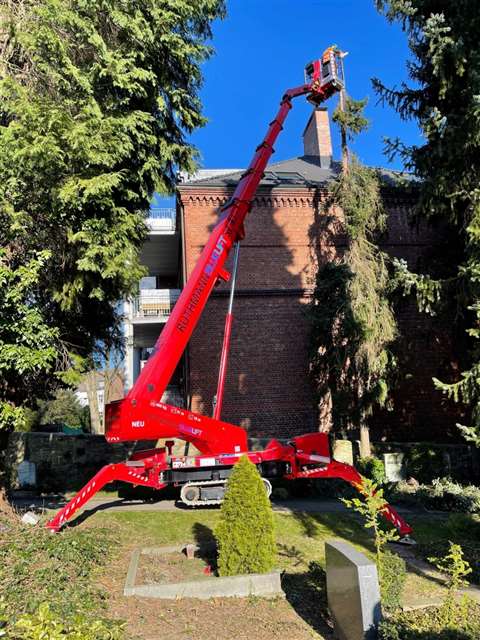 The Ruthmann BLUELIFT ST 31 tracked platform. (PHOTO: Ruthmann)
The Ruthmann BLUELIFT ST 31 tracked platform. (PHOTO: Ruthmann)
These are all benefits “you don’t always have at the same level in a smaller company,” Christensen explains.
It was also in the company’s favor that they are “lift people.”
“We have deep roots in the industry and that has been a strong advantage in the process,” Christensen says. “We could quickly elevate the focus to the core key elements of the business, including keeping the customer in the center of everything we’re doing. In closing on this, we have for sure come out a much stronger company than we were before the mergers, with a broader product portfolio, more opportunities and great leadership.”
Strong demand for ‘niche’ aerials
Speaking about today’s market, Christensen says, “We are very fortunate to find ourselves in growth mode on all levels, demanding more hands-on deck and we’re still looking for new talent to join our teams. Also, with today’s information technology we are able hire employees in various regions of the country, bringing them closer to our customers and local market needs.”
The company is experiencing strong demand across all of its product lines, Christensen says, and it expects 2023 to be a continuation of this year’s successes.
“On the track-based segment we continue to see a growing market for the so-called ‘spider’ type, or compact tracked lifts with outriggers like the Bluelift,” he explains. “From being a somewhat niche-oriented category just a few years ago, this product type and concept have now become a well-known category, and the market is finally waking up to the tremendous flexible abilities of this type of equipment and how it both more safely and efficiently can replace other means of aerial access.”
Additionally within the track-based segment, Ruthmann ReachMaster’s Bibi and Jibbi lines are doing quite well, with interest growing for these niche products from the market.
“Both are new category concepts in North America, and it has been a great experience to develop the market for these niche-product and watch how rental companies and end-user realize how amazing these units are,” Christensen says. “Their ability to work safely on unlevel surfaces in surroundings that is off-limit for traditional scissor lifts has proven a strong argument.”
As the track-based compact lift category has firmly established itself as a stable and solid product for both rental and end-users, Christensen expects to see a continued increase in demand, even if these units serve as replacements for some “mainstream products.”
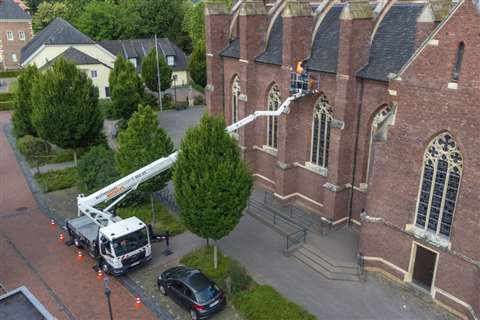 The STEIGER T 330 XS Hybrid from Ruthmann (PHOTO: Ruthmann)
The STEIGER T 330 XS Hybrid from Ruthmann (PHOTO: Ruthmann)
“The ROI on this category is very attractive,” Christensen says of the benefits. “The same projections go for the more niche oriented products as they move from novelties to established categories.”
Track-based units ‘here to stay’
Despite the general market positivity, Christensen is never one to mince words. The company’s not immune to challenges, and the biggest one it currently faces comes down to pricing.
“International shipping costs and pricing have gone up 300 percent in just six months, while service has gone down with about the same or higher proportions.” he tells me. “Even well-reputed European and American shipping lines are offering customer service that makes your local IRS office shine and schedules as precise as a drunk sleepwalker. The international shipping industry has utterly failed to align their operations to the current market conditions, which combined with the congestion in most North American ports and shortage of domestic trucking certainly adds delays and frustrations for our customers.”
But Christensen, like Sir Winston Churchill, takes the high road.
“The compact tracked-based units are ‘here to stay,’ and I think we will see maybe a change in evaluation of the technology applied for these units,” Christensen says. “When the compact, track-based units hit the market about 15 years ago, they were all perceived as very much alike.”
Christensen explains the concept: narrow, but top-heavy, bodies on rubber tracks with four outriggers, driven (for the most part) by a combustion engine and few batteries. The units could be used in areas with limited access and weight restrictions. Often, however, the differentiation factor was price and color.
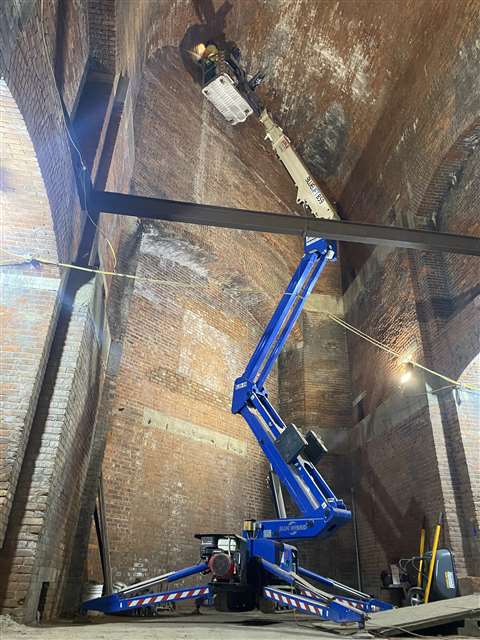 Ruthmann ReachMaster says the track-based aerial sector was somewhat a niche-oriented category just a few years ago, but today, the product type and concept have become well-known. (Photo: ABLE Equipment Rental)
Ruthmann ReachMaster says the track-based aerial sector was somewhat a niche-oriented category just a few years ago, but today, the product type and concept have become well-known. (Photo: ABLE Equipment Rental)
“The fact that the suppliers in the segment applied very different technology, quality and performance factor/limitations were often overlooked, including whether the operating system was based on old school relay and print board technology or applying modern CANBUS operating systems,” he notes. “Now, the units have been in the market for more than a decade and owners have experienced operational differences in both maintenance and residual value, so we started to see a change in the evaluation of the category and more focus on the technology applied.”
Christensen provides an example: in 2010, the company launched lithium battery powered solutions in tandem with a combustion engine on its Bluelift models, making the unit “extremely unique.”
“Today, we see an adaption of that concept across the board,” he says. “We also see the market getting even more focused on electric solutions, prompting increased demand for telematics and off-site diagnostic tools, which all cater into the more advanced technology. Those who stays on the forefront of that will probably see the greatest opportunities as the North American customer base has become much more educated as far as evaluating differences in the applied technology and performance.”
When focusing on the large, truck-mounted products – which, Christensen notes, operate within a very different market segment from Ruthmann ReachMaster’s other offerings – the increased demand for not only sustainable energy sources like wind power, but also updating and replacing the old power grids across the country, will remain strong.
“The increasing recognition in most industries of the safety and efficiency benefits of truck-mounted aerials over more traditional North America methods for working at heights greater than 100 feet has driven demand increases for rentals and end user purchases at a rapid pace,” he says.
Truck-mounts and CDLs
The wild card, however, will be the smaller, non-CDL truck-mounted units, where product awareness within the market hasn’t quite yet hit peak levels. Christensen explains that traditionally, the non-CDL small, truck-mounted market in North America has been characterized by relatively low work heights in the 30- to 50-foot range. Europe, however, ventured into taller units well over a decade ago with a much higher and concentrated focus on developing the weight/height ratio technology, driven by the strict European CDL legislation and requirement for vehicles over approximately 7,700 pounds.
“While transferring a self-propelled lift across the pond is fairly simple, the truck-mounted segment represents the challenge of different truck chassis supply between the continents,” he says. “So, transferring the concept from Europe to here requires the ability to design and built a kit that can be mounted locally in the U.S. on a U.S.-sourced chassis as it is cost prohibitive to ship the chassis back and forth for the smaller non-CDL units.”
Ruthmann ReachMaster has overcome this challenge, Christensen notes, in large part thanks to its corporate development.
“The immediate response we have from the market is very positive, and fitting well into the forthgoing trends, where there will be even more focus on efficiency (like the ability to move the unit from one application to another), operational safety and the environment,” he says.
Five years ago when Ruthmann ReachMaster (then, ReachMaster) launched the T-108 as a non-CDL unit, it caught a lot of attention, Christensen says, but due to the unit being a “top-shelf product” from a quality and price point of view, it took a little time for customers to see the operational value and cost cutting ability of the units.
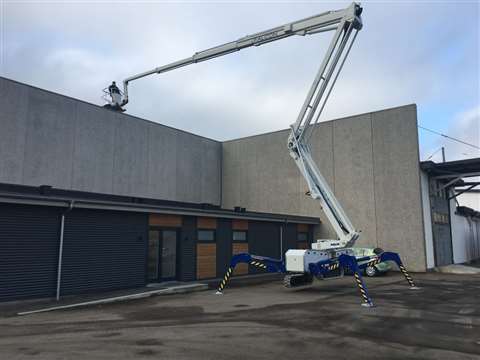 (Photo: Ruthmann ReachMaster)
(Photo: Ruthmann ReachMaster)
“That has changed now, and we have a waitlist for them,” Christensen says. “We believe the smaller Ecoline even more clearly demonstrates the value of having a safe access solution you can bring with you from job to job. It effectively eliminates down time caused by waiting for a self-propelled MEWP to be moved from one jobsite to another, or the need for deploying several units to various location instead of just bringing it along yourself.
“The development of opportunities for this category will depend on a mix of product education/awareness and local chassis availability, which, to a large degree, follows the same challenges and restrictions as the general car and pickup truck market.”
When pressed again about challenges, Christensen says one word can sum everything up: supply.
“And by ‘supply,’ I mean in the widest understanding of the word: From supply of components, completed products and parts over supply of reliable international and domestic shipping solutions to supply of qualified employees,” he explains. “To efficiently address it and “meet the needs,” it is paramount with short corporate communication lines, ability to make decisions, be quick on your feet and change direction as needed and always be open to new solutions.
“If there ever was a time to think outside the box, this is it; the best way to address challenges and change, is to embrace them and work with them instead of against them. Above all, keeping and maintaining a positive mind remains our strongest weapon against any challenge.”
STAY CONNECTED



Receive the information you need when you need it through our world-leading magazines, newsletters and daily briefings.
CONNECT WITH THE TEAM







